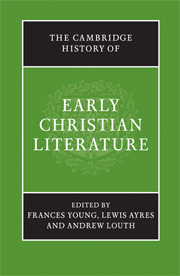Book contents
- Frontmatter
- PART ONE The Beginnings: The New Testament to Irenaeus
- A LITERARY GUIDE
- 1 Introduction: the literary culture of the earliest christianity
- 2 The apostolic and sub-apostolic writings: the New Testament and the Apostolic Fathers
- 3 Gnostic literature
- 4 Apocryphal writings and Acts of the martyrs
- 5 The Apologists
- 6 Irenaeus of Lyon
- B CONTEXT AND INTERPRETATION
- PART TWO THE THIRD CENTURY
- PART THREE FOUNDATION OF A NEW CULTURE: FROM DIOCLETIAN TO CYRIL
- Bibliographies
- Index
- Map: The Roman Empire in the late fourth century AD"
- References
4 - Apocryphal writings and Acts of the martyrs
from A - LITERARY GUIDE
Published online by Cambridge University Press: 28 March 2008
- Frontmatter
- PART ONE The Beginnings: The New Testament to Irenaeus
- A LITERARY GUIDE
- 1 Introduction: the literary culture of the earliest christianity
- 2 The apostolic and sub-apostolic writings: the New Testament and the Apostolic Fathers
- 3 Gnostic literature
- 4 Apocryphal writings and Acts of the martyrs
- 5 The Apologists
- 6 Irenaeus of Lyon
- B CONTEXT AND INTERPRETATION
- PART TWO THE THIRD CENTURY
- PART THREE FOUNDATION OF A NEW CULTURE: FROM DIOCLETIAN TO CYRIL
- Bibliographies
- Index
- Map: The Roman Empire in the late fourth century AD"
- References
Summary
‘Apocrypha’ and ‘apocryphal’ originally signified something hidden or secret, and they were applied in this sense to esoteric writings, that is, writings which circulated only within a narrow group of persons ‘in the know’. Thus one second-century Christian writer speaks of ‘apocryphal and spurious writings’ produced by Marcosian gnostics. However, the term soon enough came, in Christian circles, simply to mean ‘false’ or ‘spurious’. Taken in this sense, the label might convey one or more of the following judgements: that the work contained falsehood or doubtful teaching; that it made an illegitimate claim as to authorship; or, finally, that it was no part of a church’s received list of authoritative books. The expression ‘apocryphal literature’ is thus a vague one. In practice it refers to what might be called the popular literature of early Christianity or some sector thereof. Not many such writings were actually candidates – in whatever circle or locale – for official or canonical status; but all were taken seriously by their audiences, many had a wide audience, and some had an abiding influence on Christian belief and practice. In this category it is reasonable to include the literature of the so-called ‘Acts of the Martyrs’; for while these never claimed official status in any locale, they were no doubt widely circulated and read (perhaps even, on occasion, at assemblies of the church), and constituted a literature that at once inspired, entertained, edified and persuaded.
- Type
- Chapter
- Information
- The Cambridge History of Early Christian Literature , pp. 28 - 35Publisher: Cambridge University PressPrint publication year: 2004
References
- 3
- Cited by

